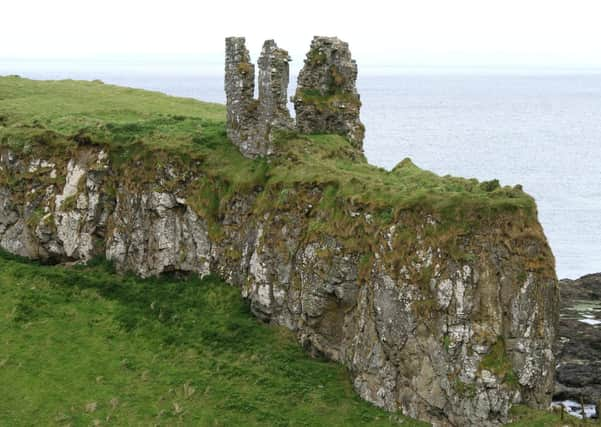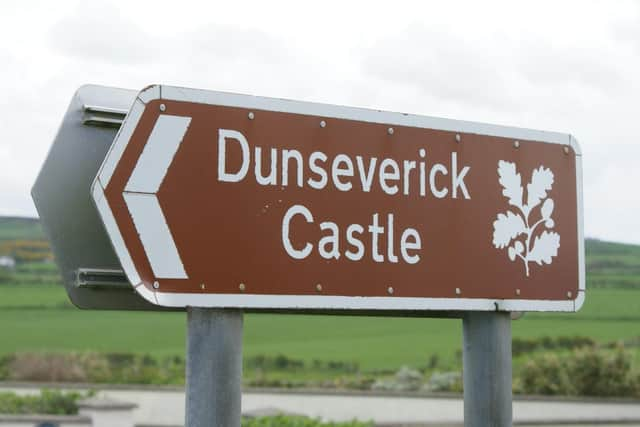St Patrick sat on a rock when he came to old castle on the coast


“Ego Patricius, peccator rusticissimus et minimus omnium fidelium…” are the opening words of Saint Patrick’s confession.
The modern translation of the 5th century patron saint’s Latin writings is, “I Patrick, a sinner, a most simple countryman, the least of all the faithful…”
Advertisement
Hide AdAdvertisement
Hide AdBut Patrick’s remarkable Christian humility will mostly be ignored today in lieu of green hats and shamrocks, with perhaps a momentary pause at one of the legendary locations associated with his historic mission in Ireland - such as Dunseverick Castle on the Antrim Coast, a lesser-recounted saintly site.


The evocative remnants of the once-magnificent fortress have been mentioned on this page before, but today’s timely return to Dunseverick, on behalf of Saint Patrick, is signposted by an almost two-century-old edition of the endearingly-named Dublin Penny Journal.
Compiled by the eminent Irish historian J. O’Donovan, with authoritative quotes about Patricius, the nostalgically low-cost publication investigated the Saint’s sojourn in and around Dunseverick.
“I am fully convinced,” wrote O’Donovan in 1833, “that unless we quote original and authentic manuscripts for the proof of Irish history, our arguments are baseless, and we leave the history of Ireland the same muddy thing which it has always been.”
Advertisement
Hide AdAdvertisement
Hide AdSo O’Donovan quoted from the original Book of Armagh’s Life of St. Patrick, “which distinctly points out the situation of Dun Sobhairce” - the Castle’s early Gaelic name - where Saint Patrick baptised Olcán, a local man who later became a Bishop of Ireland.


O’Donovan’s article in the Dublin Journal grappled heroically (and confusingly!) with the derivation of the castle’s name.
“Dunseverick, or Dunseverig”, he wrote, “is evidently an anglicizing of its Irish name, Dun Sobhairgi, or, as it is called in the Book of Armagh, Duin Sebuirgi, which is pronounced Doon Severgi”
O’Donovan’s quotations from the Book of Armagh demonstrated Patrick’s busy schedule around the Londonderry and Antrim coast.
Advertisement
Hide AdAdvertisement
Hide Ad“He (St. Patrick) came to Ardstrath, and ordained Mac Ercae bishop, and departed to Ard Eolerg (a rock over Lough Foyle) and to Ailgi, (Ailigh, six miles north-west of Derry) and to Lee-Bendrigi (later a Coleraine barony) and crossed the River Bann, and blessed the place where is the little cell of Cuil Raithin (Coleraine) in the plain of Eilniu, in which there was a bishop.
“And he erected many other cells (or churches) in the plain of Eilniu, and he crossed the Buas (undoubtedly the river Bush) and at Duin Sebuirgi sat upon a rock, which is called St. Patrick’s rock to this day, and there he consecrated a holy Olcán bishop, whom he himself had educated, and he returned into the plain of Eilne, and erected many other churches which the Coindiri (inhabitants of diocese of Connor) possess.”
O’Donovan tempered any certainty of the saint’s sojourn in Dunseverick: “we must therefore hope that our own veracity in stating facts, will be depended upon, although it must be acknowledged that the sincerest enquirers after truth frequently labour under a fond delusion”!
But he corroborated his information by quoting the ‘Abbe Ma-Geoghegan’ a History of Ireland published in Paris in 1758.
Advertisement
Hide AdAdvertisement
Hide Ad“He (St. Patrick) afterwards proceeded through the territory of Dalriada, at present called Route, in the county of Antrim, as far as the castle of Dun Sobhairche, in the northern extremity of this territory.”
Some 90 years after J O’Donovan wrote his article about Dunseverick in the Dublin Penny Journal, the Rev. Hugh Forde’s book was published entitled, ‘Sketches of Olden Days in Northern Ireland.’
A former Rector of Tamlaghtfinlagan Parish and Canon of Londonderry, Rev Forde’s writings in 1923 covered many areas of the North Coast including Dunseverick.
He narrated (with some spelling errors!) much of the castle’s remarkable and colourful history.
Advertisement
Hide AdAdvertisement
Hide AdThought to be impregnable, Dunseverick was completely routed by attackers around the year 870 - “by whom it is not said” - and the castle “was plundered by Mave, Queen of Connaught, but the date is uncertain. She came into Ulster with a great host of warriors from Connaught, and amongst other places she surprised Dunseverick, and drove off a great herd of cattle, and amongst them was the famous ‘tarif bhan’ (white bull) of Cuiligne. This started a long and bloody war between Ulster and Connaught.”
Amidst many vivid details, Rev. Hugh Forde wrote: “the most curious thing about this castle is a well on the north side, about three yards from the edge of the cliff, which is over one hundred feet above the sea. This well, it is said, never goes dry.”
Rev Forde was referring to ‘Tubber Phadrick’ or St. Patrick’s Well.
“It was at one time considered one of the holy wells of Ireland,” Rev Forde continued, quoting that St. Patrick “visited Dunseverick on several occasions.”
Advertisement
Hide AdAdvertisement
Hide AdRev Forde confirmed that Patrick baptised a young St. Olcán in the well “who afterwards became Bishop of Annoy, now a small town in North Antrim.”
“A large stone stood beside the well, called St. Patrick’s Rock” wrote Forde, adding, “it was tumbled into the well by attackers.”
Prior to its tumble, the Saint “used to sit on this stone when he came to Dunseverick.”
Roamer wishes everyone a safe, healthy and happy St Patrick’s Day.